Wombat’s City Hostel, formerly the Sailors’ Home
By the Survey of London, on 19 April 2019
This hostel on Dock Street sustains an institutional use that has its origins in the 1830s when the establishment opened as the Sailors’ Home, a reflection of the dependence of the southern parts of Whitechapel on maritime life. It is a large complex that extends back to Ensign Street (formerly Well Street), its original front.
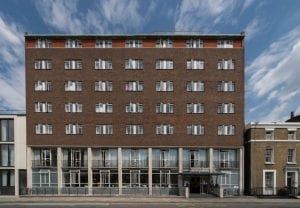
Wombat’s City Hostel, 7 Dock Street, London E1. View from the west in 2017. Photograph by Derek Kendall for the Survey of London
The Sailors’ Home, also known at first as the Brunswick Maritime Establishment, was built in 1830–5 with Philip Hardwick as its architect. Enlarged to Dock Street in 1863–5, substantially altered in 1911–12, rebuilt on the Dock Street side in 1954–7, adapted to be a hostel for the homeless in 1976–8, and again converted to be a youth hostel in 2012–14, this has been, mutatis mutandis, a major local presence for nearly two centuries, all the while used as a hostel. As the first purpose-built short-stay hostel for sailors anywhere, it represented in its original form the invention of a building type, the Royal Hospital for Seamen in Greenwich notwithstanding. It was to have seminal influence on the development of lodging-house architecture.
The story starts with a catastrophe, the collapse of the Royal Brunswick Theatre just days after its opening in February 1828. Thirteen people died and Hardwick, the architect at the neighbouring and then building St Katharine’s Docks, was the first on the scene of the disaster to take responsibility for the rescue operation. Of the theatre, all that survives is on the Ensign Street pavement, a row of (listed) cast-iron bollards with crowned ‘RBT’ monograms.
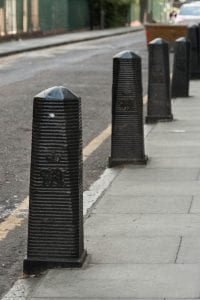
The Royal Brunswick Theatre bollards of 1828 on Ensign Street, photographed by Derek Kendall for the Survey of London in 2017
The prevalence of sailors in east London’s riverside districts was not new at the beginning of the nineteenth century, but populations did increase and living conditions declined. The end of the Napoleonic Wars in 1815 left an estimated 100,000 seamen redundant from the Royal Navy. The Rev. George Charles ‘Boatswain’ Smith (1782–1863) came to the fore in addressing the lot of these sailors through evangelism. A seafarer himself in his teens who had served with distinction under Nelson in the battle of Copenhagen, Smith had become a Baptist missionary. He established a floating sanctuary on a remodelled sloop and took the former Danish Church in Wellclose Square for use as a Mariners’ Church. A witness to extreme poverty and deprivation, he was instrumental in the taking of a warehouse in Dock Street to establish an asylum for destitute sailors that opened in January 1828. Smith was also a pioneering advocate of temperance.
Paid upon coming ashore, sailors, both naval and mercantile, were prey to exploitation and theft by boarding-house and brothel keepers and others, a practice known as ‘crimping’ that was widespread and generally tolerated. Smith was determined to force reforms and had tried to introduce a system of approved boarding houses as used in other ports. In his eyes the Royal Brunswick Theatre and its predecessor, the East London Theatre, had been a haven for crimping. The collapse presented an opportunity. In September 1828 Smith convened a meeting on the site with a view to raising there ‘a General Receiving and Shipping Depot for Mariners’.[1] This was to be a religious mission, aiming at moral reform through reducing the influence of prostitution and drink. As such it was a late example of the Georgian impulse to improvement and control through institutional architecture. Alongside Smith were Captains Robert and George Cornish Gambier, RN, brothers, and nephews of Admiral James Gambier, himself an evangelical, and Capt. Robert James Elliot, RN, who was also a topographical artist. Appeals were launched in early 1829, aiming to unite ‘the Regularities of social Order with the moral Decencies of Life, the Principles of Christian Loyalty, and the Duties of Religion.’[2]
Within the year eminent naval and other figures had been recruited to promote fund-raising (first trustees included William Wilberforce) and the freehold of the site was obtained. But Smith, an uncompromising and combative character, fell out with George Gambier, the Treasurer, over the latter’s unworldly sympathies for Henry Irving’s radical Nonconformity that had led him to leave fund-raising to faith. Smith stepped down as Secretary and set up a rival Sailors’ Rest project leading other Dissenters to withdraw support for the Home. Elliot took charge as the Home’s Secretary and steered the project into Anglican safety. Hardwick was engaged and on 10 June 1830 Elliot laid a foundation stone. Hardwick conceived the project in stages, to be built gradually as funds became available, ultimately to provide space for 500 men, each with their own cabin or sleeping place. Progress was slow and the Home did not open until 1 May 1835, with accommodation for 100 men on its lower levels. The first sailors admitted were the crew of an American ship in St Katharine’s Docks. A peaceful atmosphere introduced by the ‘sobriety and steadiness’ of these ‘temperance men’ was broken a few days later by the arrival of English sailors, coming from India and bringing ‘intoxication, swaggering and noise’.[3]
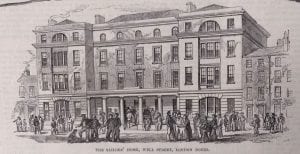
The Sailors’ Home of 1830–5, Philip Hardwick, architect, from the British Workman, 1857 (courtesy of Tower Hamlets Local History Library and Archives)
The Sailors’ Home’s façade echoed that of the theatre in its bay rhythm and the ground-floor channelled rustication. It may even be that the lower-storey wall was not wholly rebuilt. Hardwick connected the outer bays with a portico of large cast-iron Doric columns similar to those he had placed at St Katharine’s Docks. These columns were removed in 1952. The central part of the basement was a vaulted store that survives as a bar. The main central space at ground-floor level was a waiting hall open to all seamen. It had a York stone-flagged floor with a grid of nine tall cast-iron columns. The floor and columns are both still partly extant, but concealed. This hall was also used for assemblies and worship, and had small box offices for payment and registration, where the men’s ‘characters’ were recorded. Flanking dormitories named ‘Bombay’ and ‘Calcutta’ had two tiers of cabins, probably drawing on the precedent of Greenwich Hospital’s accommodation for naval pensioners. On the originally comparably tall first floor a central dining and reading hall had a similar array of columns and was flanked by two more double-tiered dormitories (‘Canton’ and ‘Madras’). Upper floors were initially used for a school, lecture room and museum of ship models and curiosities. As inmate numbers grew in the 1840s the outer upper-storey rooms were gradually fitted up as further dormitories, and a single bath was introduced.
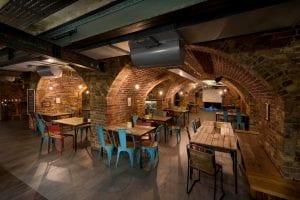
Basement vaults in the building of the 1830s, converted to use as a bar. Photographed in 2019 by Derek Kendall for the Survey of London
Henry Mayhew, in a full description that was not uncritical of the Home’s management, noted in 1850 that seamen addressed the institution’s officers as friends not as superiors, and recorded a testimony from one among them that ‘the steadiest-going seamen will always speak well of the Sailors’ Home’.[4] Henry Roberts, closely familiar with the Home having acted as its architect in the 1840s when he was also the first architect of the pioneering Society for Improving the Condition of the Labouring Classes and responsible for model lodging houses, later acknowledged that the Sailors’ Home ‘must in some respects be considered the prototype of the improved lodging-houses.’[5] Annual numbers of boarders rose from 528 in the first year to 3,833 in 1842 and 8,617 in 1861. Most of the sailors were of British or North American origin, but not all. By 1862 there had been 544 boarders from Africa.
Land behind the Home had been leased in 1842 with a view to possible extension, and was used in the meantime as a skittle ground. Dock Street was widened in 1845–6 and parts of the new frontage were acquired between 1854 and 1862 when Edward Ledger Bracebridge, a Poplar-based architect, designed a new block facing Dock Street. Lord Viscount Palmerston laid the foundation stone on 4 August 1863 and the Prince of Wales opened the building on 22 May 1865. A commemorative stone plaque bearing that information is still to be found facing the hostel’s internal courtyard where it was moved, recut, in 1956.
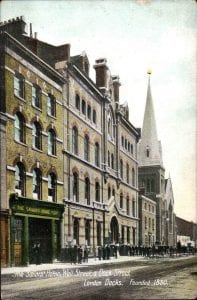
View down Dock Street showing the Sailors’ Home extension of 1863–5, with St Paul Dock Street beyond
The outwardly Gothic and polychrome Dock Street building’s basement housed a navigation school, a recreation room and two baths. The ground floor had offices to the front, including a seamen’s savings’ bank, with waiting halls to the rear, the first floor a boardroom and officers’ mess room to the north, and a library and recreation hall to the south. The two upper storeys were laid out as a single room, the Admiral Sir Henry Hope Dormitory. This extraordinary space comprised four galleried tiers of sleeping berths or cabins (108 in all) to east and west of an atrium open to the roof with south-end staircases (see images in Historic England Archives). The gain in accommodation was 160 berths for an overall capacity of 502.
In 1874–5 a single-storey skittle alley to the rear was reconstructed, extended to the south and raised to be a three-storey and basement range to provide an additional dormitory for ships’ mates and a clothing store, sales of clothing from the Home having been introduced in 1868. John Hudson and John Jacobs, both of Leman Street, were architect and builder respectively. A drinking fountain near the northwest corner of what was the main waiting hall is surmounted by an inscribed plaque recording a benefaction of 1873 from William McNeil, a formerly resident seaman.
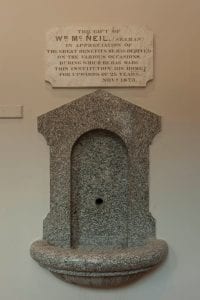
Drinking fountain and plaque on what was an internal wall of the waiting hall, photographed by Derek Kendall in 2019 for the Survey of London
By this time there were many other hostels for sailors, but the Sailors’ Home was the parent exemplar. Outside, crimping was still prevalent, and the Home was drawing more than 10,000 boarders annually. Ale was served, but there was no bar. It remained a Christian foundation, but not zealously so, aiming to ‘encourage habits of decorum, economy, and self-cultivation, and to contribute in educating [seamen] as missionaries of Commerce to the ends of the earth’.[6] Between 1879 and 1884 Joseph Conrad (Jozef Korzeniowski) stayed several times at the Home and studied in its navigation school. Conrad called the Home a ‘friendly place’, ‘quietly unobtrusively, with a regard for the independence of the men who sought its shelter ashore, and with no ulterior aims behind that effective friendliness.’[7]
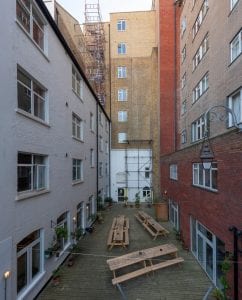
Internal courtyard from the north, showing the 1870s range to the left, a surviving section of the 1860s building straight ahead and the back of the 1950s building to the right. Photographed in 2019 by Derek Kendall for the Survey of London.
In 1893–4 the original building’s south range and a stable yard beyond were replaced by a Mercantile Marine Office, which building survives on Ensign Street. That sacrifice reduced the Home’s capacity to 300, a limit that had further to be reduced to 200 following a threat of closure in 1910 when the LCC stipulated improvements to the original dormitories, in particular for the provision of light. Murray, Delves & Murray, architects, oversaw works carried out in 1911–12 that involved the insertion of an additional floor in the Ensign Street block. Internal reconstruction formed a light-well above the ground-floor waiting hall, with structural steel carried down to the basement. Bars and a first-floor chapel were introduced and a house was demolished to permit the formation of windows in the Home’s north flank wall, which was faced with channelled rusticated render. Following this reconfiguration the establishment rebranded itself, incorporating as the Sailors’ Home and Red Ensign Club in 1912. Despite the reduced berths, the numbers of boarders continued to average more than 10,000 a year. By 1919 the Home had admitted a total of 639,005 sailors, 336,088 of them English, 51,388 from Sweden, Norway and Denmark, 18,500 from Germany, 11,376 from Russia, 2,483 from the ‘Cape and Mauritius’, 1,154 from West Africa, 7,958 from the West Indies, 2,523 from the East Indies, 1,914 from South America, and 1,387 from China and Japan. After this, the origins of the sailors were no longer recorded in annual reports.
More than 20,000 were boarded in 1933, usage that was sustained after the war when the merchant navy reserve pool was introduced, bringing seamen greater security of employment. Additional accommodation being needed, the Home’s architect, Colin H. Murray of Murray, Delves, Murray & Atkins, advised a comprehensive approach in 1937 and was asked to prepare plans for complete rebuilding. War meant postponement, but Murray did advance a scheme for rebuilding the Dock Street building in 1942.
By 1945 Murray was working with Brian O’Rorke on a more ambitious phased project for the replacement of the whole complex (now simply called the Red Ensign Club). This envisaged three slab blocks laid out on an offset H plan to make best use of the two street frontages, rising at the centre to twelve storeys for a total 307 bedrooms (no longer called cabins) above lower-level common spaces. LCC approval was secured, but in the post-war years building licences were not forthcoming. O’Rorke (1901–74), New Zealand born, had come to notice in placing joint third in the competition to design the RIBA’s headquarters and gone on to build a reputation for designing passenger-ship interiors. In 1946 he succeeded Edwin Lutyens as architect for the National Theatre, for which his designs remained unbuilt. He took over as architect for the new Club, leaving Murray, Delves, Murray & Atkins in charge of maintaining the existing buildings.
Costs kept rising with inflation and a diminishing number of boarders gave rise to concern in 1949 that expansion was no longer warranted. O’Rorke scaled down the plans by two storeys, and a licence for the first phase was granted in 1950. A new problem arose when the Merchant Navy Welfare Board was unable after all to contribute funds. With a shortfall of £35,000 of an estimated £275,000, and costs still rising, in 1951 O’Rorke suggested rebuilding the Dock Street range with the taller central block to its rear for £160,000 to prevent further delay. This was agreed and Charles Price Ltd was given the contract for the new building for £179,488 in March 1952. First Hardwick’s Ensign Street block was re-modernised, to plans by Murray with R. Mansell as contractor. A staircase was inserted in the northeast corner of the ground-floor lounge, which was otherwise laid out with a billiard table and a ‘television set’. The Dock Street rebuilding ensued from 1954 and was completed in 1957 for a final cost of £218,400. Even so, the central block had also had to be abandoned, the new capacity was just 240 and there was a deficit of £63,000.
O’Rorke’s building has six storeys and a setback attic, a steel frame and reinforced-concrete floors, metal windows and copper roof covering. Above curtain-wall glazing for the façade of the two lower storeys that housed communal spaces, it is brown-brick clad, flat-faced Modernism that is herbivorous yet stark. A lighter touch was introduced in the intertwined rope-pattern ironwork of the first-floor balconettes. A lift motor-room tower rising above the southeast staircase was a remnant of the centre-block plan. There had been disagreements as to the relative size of cabins (still, after all, so-called) for seamen and officers. The hierarchical view prevailed and it was 1966 before washbasins were installed in each room.
Following the closure of the London and St Katharine’s Docks in 1968–9 and continuing financial difficulties, the Red Ensign Club closed at the end of 1974. Hostel use was quickly re-established, the buildings being converted in 1976–8 for the Look Ahead Housing Association Ltd (Beacon Hostels) to adapt the complex for single homeless men. Christopher Beaver Associates were architects for the conversion. Capacity at what came to be called the Aldgate Hostel (sometimes Beacon House) shrank from 180 to 150 beds. Many of those housed were construction workers and there was also use as a halfway house for men released from prison. By 2012 Look Ahead had closed this and all its other large ‘industrial-era’ hostels.
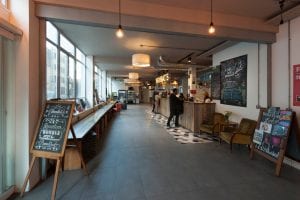
Wombat’s City Hostel’s entrance foyer from the south in 2019. Photograph by Derek Kendall for the Survey of London
Another conversion was carried out in 2012–14, the property having been acquired by Michael Sherley-Dale, whose residential property company, JMS Estates (IOM) Ltd, leased the premises to Wombat’s Hostels. This firm, founded by Marcus Praschinger and Sascha Dimitriewicz with a name deriving from the genesis of the business in their travels in Australia, had opened its first youth or backpacker hostel in Vienna in 1999 and gradually expanded across Europe. The refurbishment of the Dock Street–Ensign Street hostel was by Andrew Mulroy architects, with Eastern Corporation as the main contractors, and Peter Thompson as the project manager. Little external fabric apart from the entrance doors and canopy was replaced, but the middle range of the 1860s was raised by two storeys and the internal courtyard was landscaped as a garden. The main internal change was from single bedrooms to dormitories. Wombat’s London opened with 618 beds. In 2015 an access road to the north was infilled with a three-storey extension and an attic bedroom storey is currently being formed on the Ensign Street building of the 1830s.
References
[1] Morning Post, 11 September 1828
[2] Newcastle Courant, 28 February 1829
[3] National Maritime Museum Archives, SAH/60/2
[4] Morning Chronicle, 11 April 1850
[5] Henry Roberts, The Dwellings of the Labouring Classes, 1867 edition, p. 15
[6] Shipping and Mercantile Gazette, 24 May 1872
[7] Joseph Conrad, ‘A Friendly Place’, Notes on Life and Letters, 1912, p. 203
4 Responses to “Wombat’s City Hostel, formerly the Sailors’ Home”
- 1
-
2
Paul cooper wrote on 27 August 2021:
I stayed at the Hostel between 1984/86 formally known as “Beacon House” whilst studying Interior Design at The London College of furniture on Cermercial road E1. It was my first time away from home aged 19 from Letchworth garden city in Hertfordshire to the big city. My time there was the best of times with tenants from a cross section of society ranging from the tempory housed waiting on rehousing, tradesman especially from the northeast constructing the regeneration of the London Docklands and a wide variety of skilled and unskilled workers from around the country mainly working in Hotel and Hospitality. A diverse melting pot of wounderful charicters that became one big happy family. Im now 56 and live in The OXO Tower wharf on London`s Southbank which was redeveloped in 1995 from its run down OXO warehouse site into residential Housing and design retail at about the same time i moved back to Letchworth, so now i feel ive come back fulll circle and often go back down memory Lane to visit Dock street and surrounding areas a used to frequent all those many years ago with great fondness
Thank you for listening to an old sentimental fool
Please do check out my Facebook page if you would like to share any simular stories
https://www.facebook.com/plcooper1/ -
3
Michael Clarke wrote on 18 October 2021:
Hi Paul, I was one of the workers living there around the same time as you, from the North East, Newcastle, I’m also 56, good memories mainly, I’ve lived in Oxford for 31 years, have never been back but have often thought about it, take care Michael.
-
4
PREMCHNDRAN wrote on 27 August 2022:
I was a Sailor from India & stayed at Beacon House from Sept 1983 to Dec 1983, whilst attending London Polytechnic, preparing for Class1 MOT Examination.
Later shifted to a PG, along with a friend, across the Beacon House Hostel, to a Council house with a Bangladeshi Family and stayed there till April 1984, till I cleared my Class-1 Examination with MCA..
I was 37 yrs at that time & now turned 75.
We had a nice time at Beacon House, near to Lemon Street local Station, many Pubs & Indian Restaurants around and walking distance to London Polytechnic, which was across the London Tower and near to French Church Street Station.
After that I never got an Opportunity to visit London, rather than as a transit Passenger.
I miss those days & looking forward for few days vacation, stay at Beacon House, which is, I believe now known as Wombat’s hostel.
Hope, my dream comes true.
 Close
Close


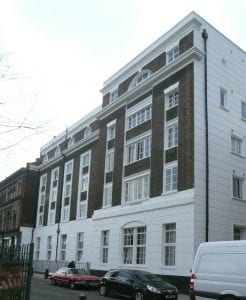

I stayed at the Red Ensign Club numerous times between 1954–1958 when in the British Merchant Navy. It was a “home away from home” and it cost four shillings and sixpence a night for a bed. As an Able Seaman my pay was 28 Pounds a month. It was alwaysbusy with Seamen coming and going. Britain had a huge Merchant Navy in those days. There was a “Welfare Officer”–a Captain Badham—who looked after men who were having problems finding a ship. I came back to Australia in 1958 and have not been to the Uk since. Tony Lawrence.